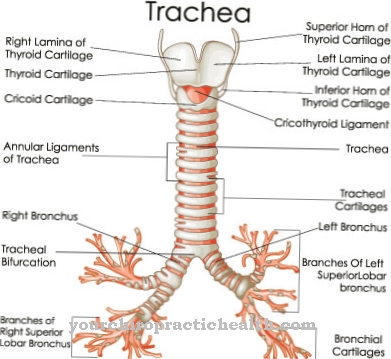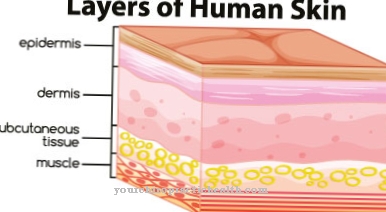The Compartment syndrome is an increase in pressure in muscle tissue caused by injury or overuse, which can lead to the death of muscles and nerves. A distinction is made between the acute and the chronic form. The acute compartment syndrome is a life-threatening emergency and must be treated as quickly as possible.
What is the compartment syndrome?

© Henrie - stock.adobe.com
As Compartment syndrome is the name given to the pressure increase in a muscle group. It leads to reduced blood flow and impairment of nerve functions.
Muscles are surrounded by a layer of connective tissue, the so-called fascia. This combines several muscles with the same function to form a muscle group called a compartment or box. The fascia is tight around the muscles and is not very flexible. If a bruise or swelling occurs in such a muscle group, the pressure within the compartment increases because the surrounding fascia does not give way.
As a result of the pressure increase, nerves, tissue and blood vessels are pinched or squeezed and thereby damaged or even destroyed in the further course. The compartment syndrome is most common on the forearm and lower leg. A distinction is made between acute and chronic compartment syndromes. The acute form must always be viewed as an emergency and requires immediate medical treatment.
causes
The causes for that Compartment syndrome are diverse. Acute compartment syndrome is most often caused by injuries, such as broken bones, bruises, or bruises.
This creates space-occupying bruises or edema (accumulation of water), the fascia cannot give way and the pressure in the compartment increases. Wounds that are sewn too tightly or a bandage that is too tight can trigger an acute compartment syndrome.
In contrast to the acute compartment syndrome, which develops in a very short time, the chronic form develops over a longer period of time. It occurs in athletes, especially long distance runners or bodybuilders. If the muscle is trained too hard and thus increases in volume in a very short time, the fascia cannot adapt quickly enough. This type of disease is also called functional compartment syndrome.
Symptoms, ailments & signs
A compartment syndrome usually does not cause any acute symptoms or complaints. However, depending on the cause, chronic health problems can arise. In acute compartment syndrome, severe pain occurs primarily, usually associated with a feeling of tension and swelling in the affected area. In addition, there are sensory disturbances and paralysis of the muscles, whereby the paralysis symptoms can become chronic if not treated.
The acute compartment syndrome often occurs on the lower leg and the back of the foot. The chronic form is also manifested by pain and feelings of tension in the affected area. It is typical of the disease that the symptoms do not appear permanently, but mainly during physical activity. The complaints quickly go away in peace. In addition, the chronic compartment syndrome can lead to misalignments, joint wear and other symptoms.
Often, as a result of the restricted mobility, there are also psychological complaints that require independent treatment. In the long term, the compartment syndrome can lead to permanent muscle damage. The quality of life of those affected is severely limited, especially in the chronic form. If the disease is treated, the symptoms usually subside or can at least be reduced to such an extent that the person affected can lead a relatively symptom-free life.
Diagnosis & course
The diagnosis for a Compartment syndrome the doctor provides based on the patient's symptoms and history. The acute form causes extreme pain, as well as swelling, numbness and tingling in the affected part of the body.
Movement is restricted, the skin is pale and cold to the touch. In the chronic compartment syndrome, there is also clearly visible swelling in the affected muscle group. However, the symptoms only occur under stress and subside as soon as the patient is at rest. The doctor can test whether a compartment syndrome is present by scanning the muscles and measuring the pressure with the aid of a probe.
A sensitivity test of the skin reveals both sensory disorders and the area in which the compartment syndrome is located. Ultrasound and X-ray examinations are used as further diagnostic measures. Tissue changes can be detected with ultrasound and a possibly underlying bone fracture can be seen on an X-ray.
Complications
The compartment syndrome is a very serious injury that must definitely be treated by a doctor. As a rule, certain muscles or tissues in the body die off, which can lead to significant restrictions in everyday life and movement. Those affected suffer from severe pain in the muscles.
These can usually affect the entire body of the patient. The pain usually spreads to other regions of the body. Furthermore, pain at night often leads to sleep problems and, due to the persistent fatigue, to general irritation. The muscles are paralyzed by the compartment syndrome and tension occurs throughout the body. It is not uncommon for patients to suffer from the typical tingling sensation.
Compartment syndrome is usually treated causally and symptomatically. In acute emergencies, surgery can be carried out. However, it cannot be guaranteed that irreversible consequential damage will not occur. If the compartment syndrome is already chronic, the symptoms can be reduced by reducing the load. Usually there are no further complications.
When should you go to the doctor?
Chronic compartment syndrome needs to be diagnosed and treated medically. Anyone who repeatedly experiences muscle pain that cannot be traced back to a specific cause should consult a doctor. Restrictions in movement, impaired sensation, and muscle weakness are other signs that indicate a serious condition and require treatment. Acute compartment syndrome also requires medical treatment. If the sick person feels severe pain or sensory disturbances in a certain area of the body, they should consult their family doctor on the same day.
Non-specific symptoms also need to be investigated if they persist for several days. Medical advice should always be sought with swelling and paralysis. The compartment syndrome mainly affects extreme athletes and people who have a physically demanding job. If you are one of the risk groups, it is best to consult your family doctor immediately if the symptoms are mentioned. Depending on the type and severity of the symptoms, a sports doctor, an orthopedist or a specialist in internal medicine can also be called in. Children are best taken to the pediatrician for unusual muscle pain.
Treatment & Therapy
The chronic one Compartment syndrome runs relatively harmless, usually a reduction of the load is enough to bring about a regression of the pressure in the muscles. The affected part of the body should be stored and cooled at heart level. Sports training is to be discontinued. Once the pressure in the muscle has normalized, you can start exercising again with slow exercise under medical supervision.
The acute compartment syndrome, on the other hand, must be treated as quickly as possible, otherwise tissue will die and life-threatening multi-organ failure can occur. If the pressure increase was caused by a bandage that was too tight, it must be removed immediately. In order to reduce the pressure in the muscle compartment, an operation called a fasciotomy is performed. An incision is made in the skin and fascia at the affected area so that the muscles can give in to the pressure and expand.
If muscle tissue has already died, this is removed. After the swelling and pressure go down, the fascia and skin are sutured. Skin grafts may be necessary. If nerves and muscles have been damaged by the compartment syndrome, physical therapy training can help after the wounds have healed.
You can find your medication here
➔ Medicines for muscle painOutlook & forecast
If a compartment syndrome is diagnosed promptly, professional treatment can also begin promptly. In this case the prognosis is quite good.
Compartment syndrome is often caused by deep vein thrombosis, edema in the legs or a lower leg fracture. Only a quick treatment allows the tissue pressure and the associated circulatory disturbance to be completely relieved. In this case, there is no risk of permanent damage. The mobility of the extremities is not permanently reduced.
However, if the compartment syndrome remains untreated for a long time, it can lead to a poorer prognosis. A persistent circulatory disorder in the muscles leads to the death of the surrounding muscle tissue. As a result, necroses are formed due to dying tissue. The scars in the affected muscles lead to more or less severe functional disorders. In the worst case, an untreated compartment syndrome can lead to joint stiffening.
If left untreated, compartment syndrome can also lead to symptoms of paralysis. In this case, too, the prospects for improvement are rather small. It is true that those affected can receive physiotherapeutic treatment for these symptoms. However, this can only restore mobility to a limited extent in the damaged areas. For this reason, the prognosis for compartment syndrome can only be good if the compression-related circulatory disorder is recognized and treated promptly.
prevention
One can counteract the acute Compartment syndrome prevent by preventing circulatory disorders and an increase in pressure. In the case of injuries to the extremities, elevation can promote the outflow of blood and inflammatory fluids. Drainage, a surgically placed tube through which blood and wound fluid can drain, is also helpful. Associations that are too close must be loosened. A chronic compartment syndrome can be prevented with adequate training.
Aftercare
In most cases, follow-up care for compartment syndrome proves to be relatively difficult, so that a doctor should be consulted quickly in this disease in order to prevent further injury to the muscles and thus further complications. Self-healing cannot occur. If the symptoms occur, an emergency doctor should be contacted immediately or a hospital should be visited.
In general, the affected area should no longer be stressed so that the muscles can recover. Bed rest is to be observed, and those affected should not perform strenuous, stressful or physical activities. The point must be shut down so that it is no longer moved.
Due to the compartment syndrome, patients may have to rely on physiotherapy or physiotherapy. Many of the exercises can also be done in your own home, which may further accelerate healing. Surgical interventions are only necessary in a few cases.
As a rule, the compartment syndrome can be treated relatively well again, whereby special follow-up care is no longer necessary. The disease also does not reduce the life expectancy of the person affected. Due to the illness, some patients are dependent on the help and support of friends or their own family in their everyday life due to the illness.
You can do that yourself
Whether self-help measures make sense with an existing compartment syndrome depends primarily on the type and severity of the disease. If it is an acute compartment syndrome, there is usually little they can do themselves to alleviate the symptoms. Surgical intervention is often unavoidable here.
The situation is different with the chronic functional compartment syndrome: Here the patient should protect and cool the respective body area. The cooling promotes swelling. At the same time, however, it is advisable to promote blood circulation - for example by elevating the legs. In consultation with the attending physician, moderate training in the aerobic area - that is, with a low heart rate - is possible and even beneficial for healing, because the connective tissue is optimally supplied with nutrients through movement.
However, the patient should keep the stress on the body as low as possible because: If the heart rate increases, as is the case with training in the anaerobic area, lactate (lactic acid) is formed. Lactic acid, in turn, leads to faster muscle fatigue and can significantly delay the healing process. The attending doctor always decides whether physical activity is an option in individual cases, and if so, to what extent.


.jpg)





















.jpg)



